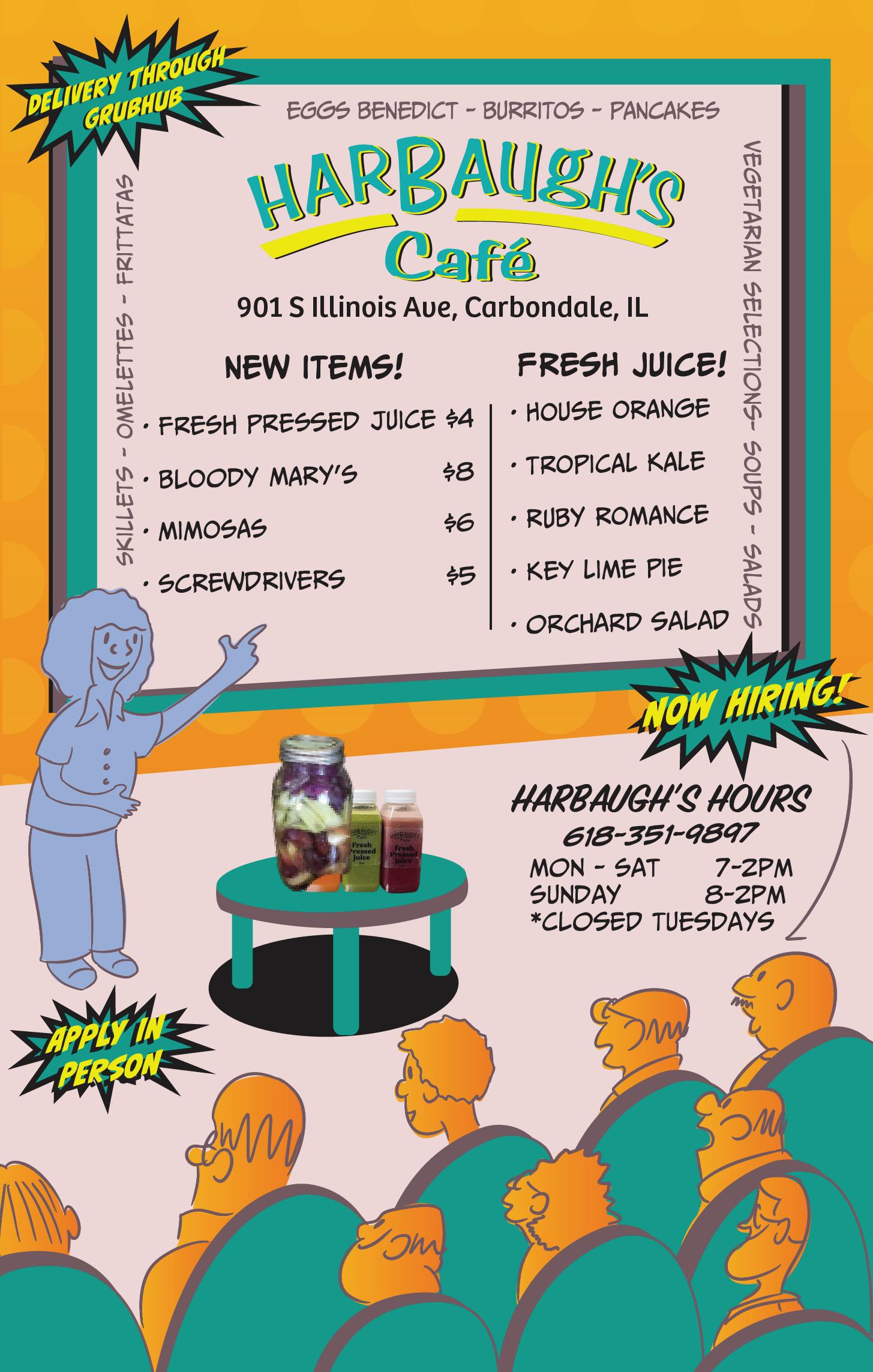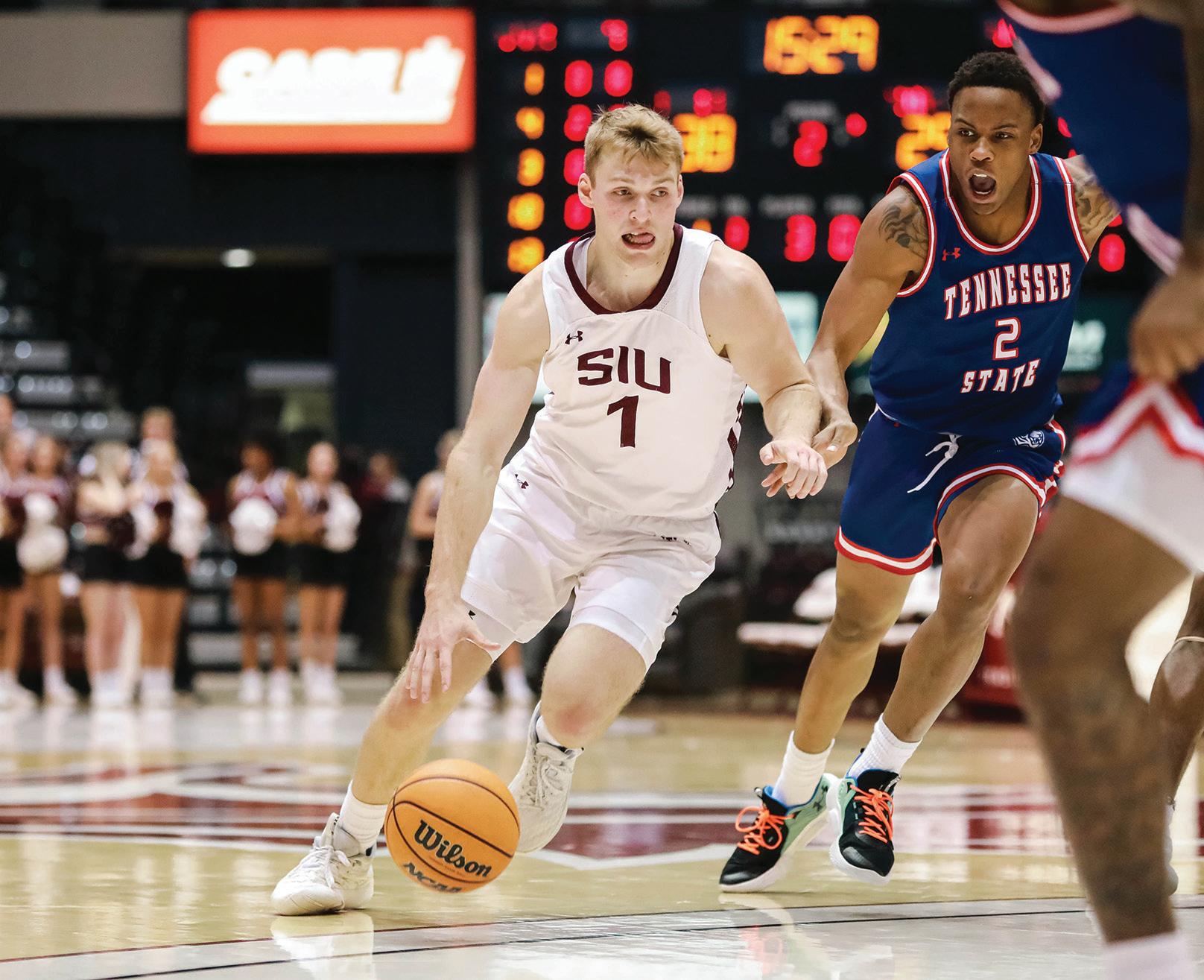p. 3
Deep Cuts: protecting





over the years,” Behrens said. “This is the tactics they used. They just didn’t sit down at the table. They made it take as long as possible. They ignored their workers. And they [the workers] lost momentum.”
So-called “union busting” is illegal in the United States, but that does not stop corporations like Starbucks from engaging in tactics that prevent workers from unionizing in the first place, let alone bargain for their demands.
“That’s why we’re out here today, it shows that we aren’t going to lose momentum, hopefully, and we can keep this fight going strong,” Behrens said.

towns,” Behrens said. “Carterville, Carbondale, Murphy[sboro], this whole area came out of coal mining, and when you think of coal miners, you think of unions.”
As manufacturing jobs are shrinking and the service industry grows, those protected jobs are becoming more and more slim. Now, workers like those at the Carbondale Starbucks are trying to recapture those same rights in their own jobs.


Three months after voting to unionize, the workers at Carbondale’s Starbucks location on Main Street joined those at more than 100 other stores across the country in a nationwide strike on Nov. 17. The strike coincided with the company’s Red Cup Day, which is said to be one of its busiest days of the year.
Ellen Cullen was one of the workers who took to the sidewalk along Main Street, holding a white sign with red letters that said, “Starbucks on strike.” They said striking on such an important day for the corporation was vital in getting their message across.
“That’s all we can really do right now, try to get them to hear our voices,” Cullen said. “Hopefully it makes a big enough dent in their sales, because that’s, I think, the
only way that they’re going to acknowledge us.”
The strike was in response to Starbucks’s actions during contract negotiations between the company and the union, Starbucks Workers United. As described by another employee, Isaiah Shepherd, Starbucks refused to bargain with them during their scheduled meeting on Oct. 31.
“Across the nation, not only us, but even with us, we’ve had personal experience where the lawyers show up for five minutes, and then go into a private meeting that lasts for hours,” Shepherd said.
“The lawyers get paid thousands of dollars, but our workers sit there at the table, getting paid nothing, volunteering to go there to try to bargain.”


Shepherd, along with many of his fellow co-workers, spent the day picketing near the drive-thru, urging

potential customers to avoid going to Starbucks for the day in solidarity with the strike. Some had been there since around 4 a.m., and all were battling cold temperatures.
They also provided their own red cups, which were similar to those that Starbucks was giving away, except it bore the logo of Starbucks Workers United. The union logo also appeared on a black beanie that several of the workers wore during the strike.
“All we’re asking is a chance to bargain at this point,” Shepherd said. “A chance to talk about it.”
The Nov. 17 demonstration was just one step in a long process for Starbucks workers to attain what they feel they deserve. Austin Behrens noted how common it is for movements like his store’s unionization to fall apart.
“Look at all the companies that have tried to unionize and failed
Unions are becoming more common in the service industry, but were historically strong in blue collar jobs, especially in Southern Illinois.
“If you just think about Illinois, and the way it used to be, a lot of towns developed from coal
James Ward stood on the sidewalk, holding a sign that said, “Don’t scab on Starbucks workers.” Having left his overnight shift at Intertape Polymer Group (IPG) in Carbondale at 7 a.m., Ward joined the strike in solidarity.
“I think it’s important to get them unionized, because manufacturing is shrinking and service industry jobs are growing, so they get stuck with a job that’s not unionized,” Ward said.
shark populations of “Black Panther: Wakanda Forever” chased off campus by protesters Game on! Salukis take on Tennessee State Brandyn Wilcoxen @BrandynWilcoxen Starbucks employees Celestial Facarazzo (left) and Ellen Cullen hold signs reading “All power to the workers!” and “Starbucks on strike” on the sidewalk in front of the Starbucks on Main Street in Carbondale during the strike on Nov. 17, 2022. Brandyn Wilcoxen | @BrandynWilcoxen A cutout of activist Mother Jones stands outside Starbucks in Carbondale during the workers’ strike on Nov. 17, 2022. Jones was a prominent union organizer in the early 20th century, and is a symbol of the American labor movement. Brandyn Wilcoxen | @BrandynWilcoxen
Email: editor@dailyegyptian.com
Faculty Managing Editor: Annie Hammock ahammock@dailyegyptian.com
Editor-in-Chief: Sophie Whitten swhitten@dailyegyptian.com
Design Chief: Seth Martin smartin@dailyegyptian.com
Photo Editor: Domonique MartinezPowell dmartinez-powell@ dailyegyptian.com
Multimedia Editor: Kylen Lunn klunn@dailyegyptian.com
Sports Editor: Joey Bernard jbernard@dailyegyptian.com

Assistant Sports Editor: Cole Daily cdaily@dailyegyptian.com
News Editor: William Box wbox@dailyegyptian.com
Ad Chief: Hannah Combs hcombs@dailyegyptian.com
Assistant Ad Chief: Isaiah Wilkerson isaiah@dailyegyptian.com
Social Media Editor: Logan Brown lbrown@dailyegyptian.com
Being a manufacturing job, Ward’s job at IPG is part of a union, so he knows firsthand the benefits that it can have for workers.
“It pays better, and our jobs are more protected if we’re unionized,” Ward said.
Although he works in Carbondale, Ward lives in Carterville. While he stood on the sidewalk with his sign, a driver on Main Street slowed down and yelled “Y’all deserve your money!” through their car window.
It was likely that many who passed by Starbucks during the strike were in the working class, possibly heading to work themselves. The labor movement tends to go down party lines, but regardless of political affiliation, local people can sympathize with service workers fighting for what they feel they deserve.
“A lot of these people here know what it means to unionize, know that it’s really important, know that it can help the people in the community that we’re in,” Behrens said. “We’re just out here trying to make people see it from our perspective.”
As workers stood on the sidewalk and near the drive-thru, they encountered a morning’s worth of traffic. Some honked their horns as they passed by in support of the strike; others pulled into the drive-thru, where workers would talk with them about their cause.
vocal of the attendees, equipped with a microphone and speaker to amplify the message of the strike. Occasionally, he could be heard leading chants of “Get up, get down, Carbondale’s a union town!”, “Starbucks, Starbucks, you can’t hide, we can see your greedy side!”, or “Hey hey, ho ho, low wages have got to go!” among others.
The SIDSA has supported Starbucks’s unionization efforts, as the organization hopes to play a role in furthering the labor movement in the area.
“I think that this strike, and the teachers strike that might be happening in District 95, it’s a good example to the working class all over Carbondale, all over Southern Illinois, that you can do this,” Herron-Titus said. “This is possible, and the community’s gonna back you up. The SIDSA is gonna back you up. The YDSA is gonna back you up. The Green Party is gonna back you up. The organized labor movement around here that has built Southern Illinois, built the public goods, will back you up. And anything is possible when we’re all together.”
Also joining the strike was Victor Ludwig, who was with the picketers near the drive-thru. Ludwig is a sophomore at SIU, and involved with both the DSA and YDSA.
“We care deeply about making places like this where service workers haven’t been respected, into places where true livings can be made,” Ludwig said.
others to do the same.
“Early in the morning, we saw a lot of people heeding our call to not go through the drive-thru,” they said. “Because for them, they understand waking up at 4 in the morning to go to a job that doesn’t treat them well. You catch that demographic at 7:45, these are all the people that are going towards their daily work, and understanding what that means. When they see a strike, it’s one of those things that a lot of people wish they could be there on the line. They wish that their job had that same opportunity. It’s a shame that many of them don’t.”
Many of the people entering the parking lot during the strike were there for a typical Starbucks order, but some came in simply to voice their support for the picketers. One visitor pulled up to the group and rolled down their window, saying “I’m not gonna buy anything, I just need to say you guys are doing awesome.”
Ludwig said, “We’ve had people trying to pass tips out the window to us. We’ve had people calling and asking how they can come out. We’ve had like 40 donuts given to us over the course of today from people dropping by and just wanting to make sure that we’re fed and happy.”
The Daily Egyptian is published by the students of Southern Illinois University Carbondale on a weekly basis. Fall and spring semester editions run every Wednesday. Free copies are distributed in the Carbondale, Carterville, and Springfield communities. The Daily Egyptian can be found at www.dailyegyptian.com or on the Daily Egyptian app!
The Daily Egyptian, the student-run news organization of Southern Illinois University Carbondale, is committed to being a trusted source of news, information, commentary and public discourse, while helping readers understand the issues affecting their lives.

The Daily Egyptian is published by the students of Southern Illinois University Carbondale and functions as a laboratory for the School of Journalism in exchange for the room and utilities in the Communications Building. The Daily Egyptian is a non-profit organization that survives primarily off of its advertising revenue. Offices are in the Communications Building, room 1259, at Southern Illinois University Carbondale, Carbondale, Ill., 62901.
@2021 The Daily Egyptian. All rights reserved. All content is property of the Daily Egyptian and may not be reproduced or transmitted without consent. The Daily Egyptian is a member of the Illinois College Press Association, Associated Collegiate Press, College Media Advisers Inc. and the College Business and Advertising Managers Inc.
Letters and guest columns must be submitted with author’s contact information, preferably via email. Phone numbers are required to verify authorship, but will not be published. Students must include their year and major. Faculty must include rank and department. Others include hometown. Submissions should be sent to editor@dailyegyptian.com
“It feels kinda small doing stuff like this, especially in a smaller town like this, but I feel like it makes a big difference…” Cullen said. “We want to try to inspire other businesses and other people who work for those businesses to stand up for themselves.”
The cafe was closed to the public for the day, and it was estimated that only three employees were handling the drive-thru.
“To be fair, they’re scared of the repercussions of not coming into work and striking today,” Cullen said. “But I don’t think it’s as much as it normally would be. There’s only a couple of people in there.”
With so few workers and only the drive-thru available, the typical morning rush backed up all the way to the street. A combination of the slowmoving traffic and convincing from the picketers lead to what they felt was a lower turnout of customers than usual.
“This time, on a normal day, we would be packed,” Starbucks worker Sheldon Griffith said. “And then throw our biggest grossing day on top of it, and there’s not business. We’re doing well.”
At 4:51 p.m., the SIU Young Democratic Socialists of America (YDSA) announced on Facebook that the store had closed for the day due to staff shortage, after the strike had been going for 13 hours.
The YDSA – and its nonyouth counterpart, the DSA – had representation at the strike as well. Positioned on the sidewalk in front of the store was Luke Herron-Titus, the co-chair of the southern Illinois chapter of the DSA.
“It’s not about one person, or one group of people. It’s about everyone,” Herron-Titus said. “Unless you are a Wall Street banker, a CEO, a manager at a steel company. If you don’t have access to those outlets of production, you’re working class.”
Dressed for the cold in a bright orange beanie hat, Herron-Titus was the most
A native of the Effingham area, Ludwig has experienced living in a place where unions are relatively weak. They see Carbondale as being capable of having a strong foundation with community support, which is the basis of the DSA and YDSA’s efforts.
“There’s a big need for the community to give back to the workers that are doing much, when the companies that these people work for don’t,” they said. “It’s all about bringing everyone together around the working class struggle.”
Like many of their fellow picketers, Ludwig reported a positive impact that the strike had; not only on deterring people from going to Starbucks that day, but on spreading the message of unionizing, and possibly inspiring
While the strike was successful on a small scale, the workers recognize that there is still a way to go in securing their rights. Having since returned to work after the single-day demonstration, they still face the task of going against one of the largest corporations in America.
“It’s going to be a long, long process,” Behrens said. “Starbucks isn’t going to make this easy. They never do.”
But these small steps, especially when compounded on a national level, will go far in showing that the workers are prepared to fight for themselves.
“We’re just trying to hit them a little hard, make them see that we’re really trying to make an effort here, and we’re not gonna back down,” Cullen said.
Staff reporter Brandyn Wilcoxen can be reached at bwilcoxen@dailyegyptian. com or on Twitter at @BrandynWilcoxen.
Hundreds of leagues away from civilization, the ocean’s most adapted predator stalks through rolling mountains of water and howling tropical storms, unfazed by any distance, natural defense or habitat. Its sophisticated senses burn through murky waters and catch prey out, its legion appetites drive it to take all the ocean has to offer. Humans are the ocean’s biggest predators, capable of inflicting grievous harm on other species in absent mindedness, and rapidly consuming them to complete extinction when it has something to gain. However, scientists like shark researcher Dr. Steven Kessel are bring humanity’s full attention to bear on the work of its fishermen, representing our long term best interests of conservation of species and the environment.
“Around one-quarter of all elasmobranch [a subclass of cartilaginous fish, including sharks] species are currently threatened with extinction,” said Kessel, who is the director of marine research at the Shedd Aquarium. “To reduce and even reverse these declines, we need good data generated by applied research to inform conservation and management initiatives.”
Kessel has many different areas of study to supervise, but he found time to present to the SIU Wildlife Society on Nov. 14 about his own special interest, the sharks of the Caribbean. Having completed his PhD in marine ecology and biology in 2009, he’s had the opportunity to study sharks everywhere from Lancaster Sound in the Canadian Arctic to the Sunni Red Sea Coast, but has alway found his way back to the Bahamas, where he originally started researching sharks for his degree.
According to Kessel, sharks are roughly 450 million years old, older than dinosaurs and even the trees our human ancestors abandoned only a few million years ago. They’ve survived eons of extinction events, and have evolved into an incredibly diverse range of about 500 different shark species in that time, with scientists discovering four to five new species every year, usually in the deep ocean.
There are sharks at every extreme of evolution. Greenland sharks are thought to be able to live up to 500 years at the most, older than any living vertebrate. The Mako shark soars through salty tropical oceans 800 times denser than air at an estimated 60 miles an hour, about as fast as a cheetah can
run on the savanna through thin air.
According to Kessel, “soaring” is a more literal description than one might think, “Another difference from most bony fish is that sharks essentially wind through the water, they don’t swim in the traditional sense that the fish are, and the reason is that they have an absence of a specialized organ, the swim bladder, that most bony fish species have. Most Teleost [bony fish with symmetrical tails and rayed fins] can inflate and deflate the swim bladder to maintain buoyancy in the water or, you know, go up or down in the water. Sharks don’t have this, they have a very large liver which is very oil filled and positively buoyant in water, salt water at least. And that helps a little bit but essentially sharks are negatively buoyant so if they stopped swimming, they would sink. They counteract this negative buoyancy using the exact same principles of flight, creating low pressure above the pectoral fins, which are essentially acting as wings, and their pelvic fins and high pressure below that.”
Even whale sharks, which can grow to be 60 feet long, bigger than some small ships, are essentially flying through water.
According to Kessel, sharks also possess a wonderful suite of seven senses, enhanced by their unique y-shaped brains, allowing them to isolate simuli and determine what direction it’s coming from better than most fish. On top of the five senses humans have, sharks also possess pressure senses (common among other fish) that allow them to notice where something is swimming in relation to their own bodies without looking. Not unique to elasmobranchs, but much more common among them than in Teleost fish is their ability to detect electromagnetic reception, the ability to detect electrical pulses like those our nervous systems use to signal to our muscles and make our hearts beat on time.
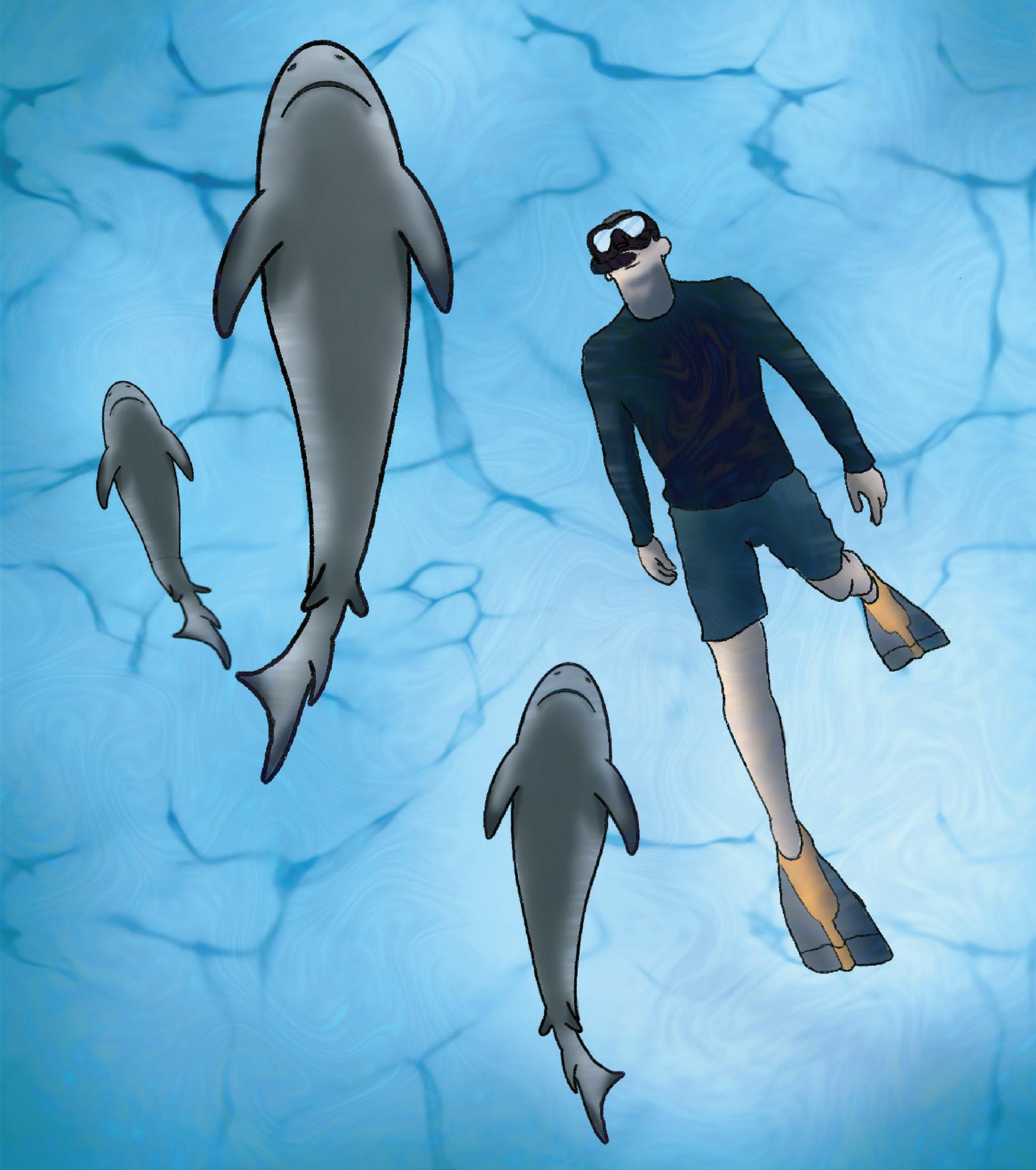
They sense this through a series of pores above the head and around the snout, which Kessel explained in detail:
“These are tubes that are run up through the snout through the head and they are filled with the potassium rich jelly and that jelly has the same electrical properties of seawater. If you turn a shark over and just look at its nose, it looks like someone sprinkled pepper in a pattern on its nose. Those pores are ampullae of Lorenzini and the front of them has very high electrical resistance. The back of them has that too and they’re connected to the brain by nerves as electrical pulses and
Devon Moon | dmoon@dailyegyptian.commagnetic pulses travel up through the ampullae of Lorenzini, there’s millions of tiny little hairs that get displaced. So the shark’s able to detect the strength of that electric field or magnetic field, but also the directions. Where it’s strongest is kind of the direction it’s coming from.”
This seventh sense of sharks can even be used for open ocean navigation in addition to predation, according to Kessel. Sharks can sense the magnetic field of the earth, guiding them when they migrate between continents or across oceans.
These traits and more made sharks well established predators, as well as a fascinating pop culture icon and research topic, but their reproductive traits leave them vulnerable to fishing companies who sell their fins for a premium at Asian markets.
Though there are a variety of different ways sharks are born, including live mammalian birth, hatching from an egg, or a combination of the two, what
they all have in common is that they are “k-selected” meaning that they have a relatively long maturation period and produce few young with each birth. Pregnancies can last for years, and newly born sharks take years, or even decades to totally mature, though they’re ready to hunt and fend for themselves from birth.
“Problem is now humans do exist and there is mechanized fishing and there is fishing and fisheries that target sharks,” Kessel said. “Because they have this k-selected strategy, it’s very difficult for them to sustain or recover from any intense fishing pressure. The main fishing pressure - direct fishing pressure - is a demand and supply situation for shark fin soup. Typically for the Asian market, especially China. They’re very highly valued for their fins. Shark fin soup is a dish that is typically served at weddings in China and throughout that part of Asia, generally at high society events. It’s very expensive. so it’s considered a sign of wealth.”
Kessel, who has visited several shark fisheries, said the operations are more often carried out by small fishing vessels seeking the premium cut of the sharks, their valuable fins. Due to the boats’ limited capacity, they dump the relatively worthless meat of the sharks they catch back into the ocean after harvesting the fins, and continue fishing for sharks, leading to large declines in the shark populations, especially near areas with large shark fisheries such as Yemen, Hong Kong and Dubai.
According to a paper that Kessel worked on with the Pew Charitable Trust Shark Conservation Committee, which analyzed data from 2000 to 2010, 100 million sharks are caught and killed every year. That’s an estimated 1 in 15 sharks being killed every year. This is the reason about a quarter of all elasmobranchs are at risk of extinction.

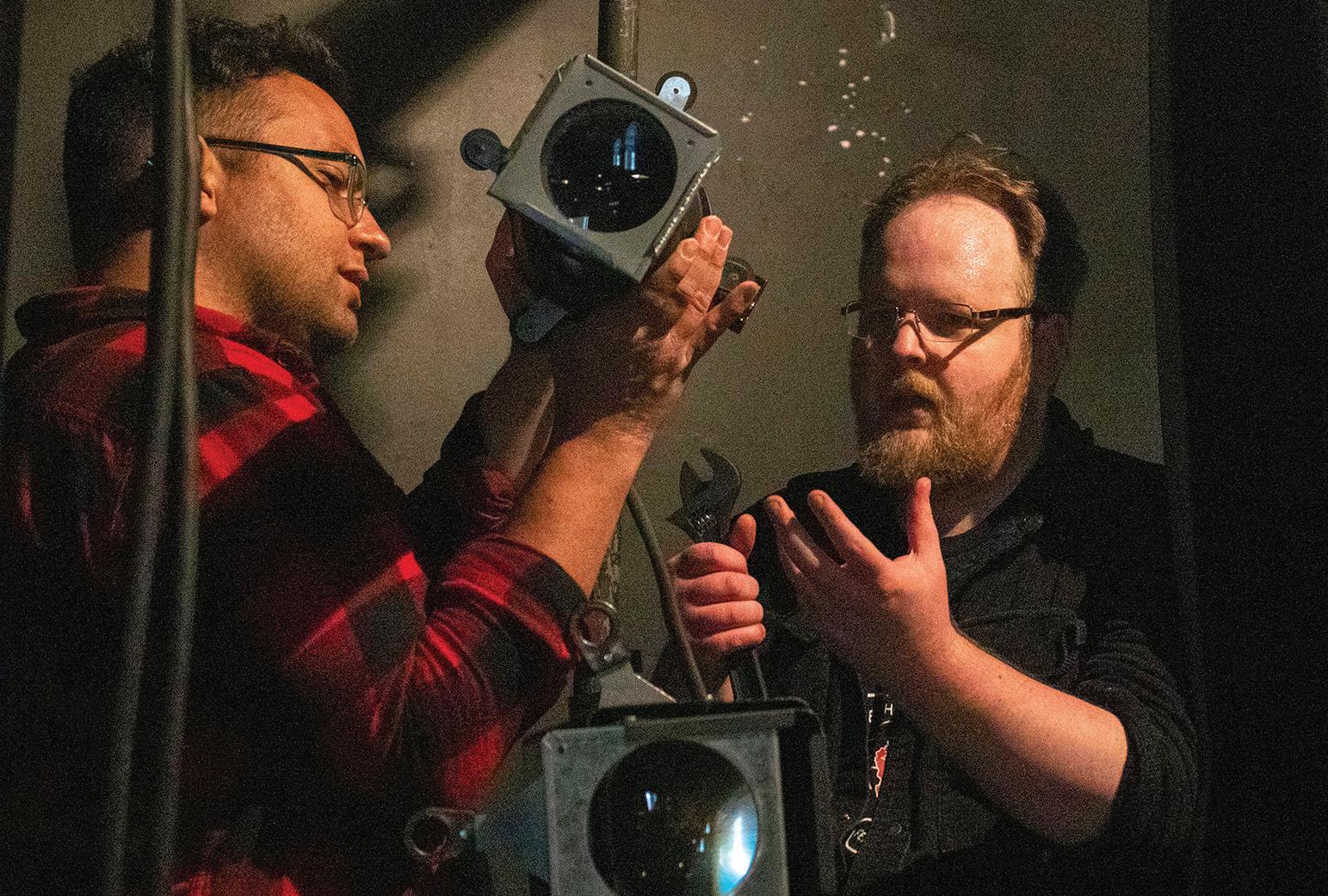

“Right
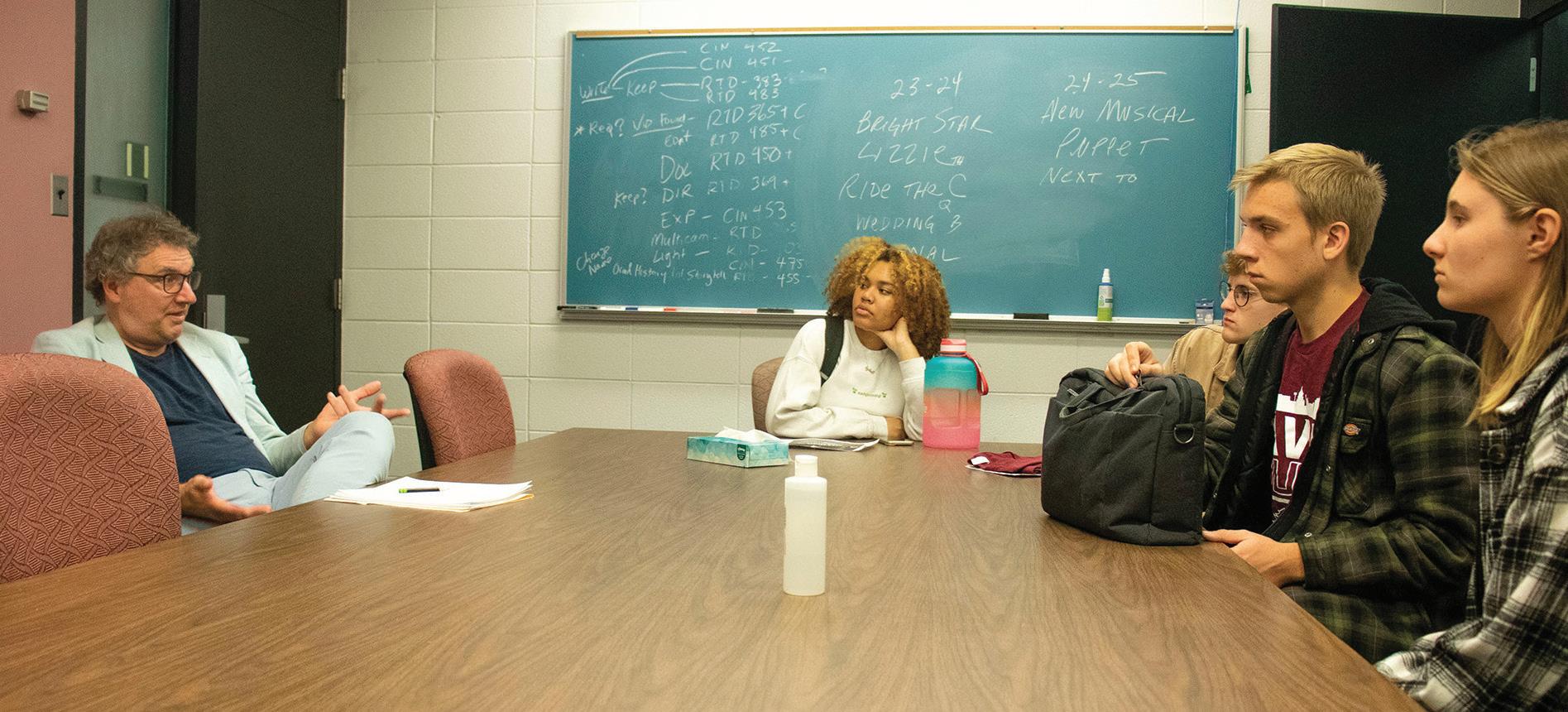

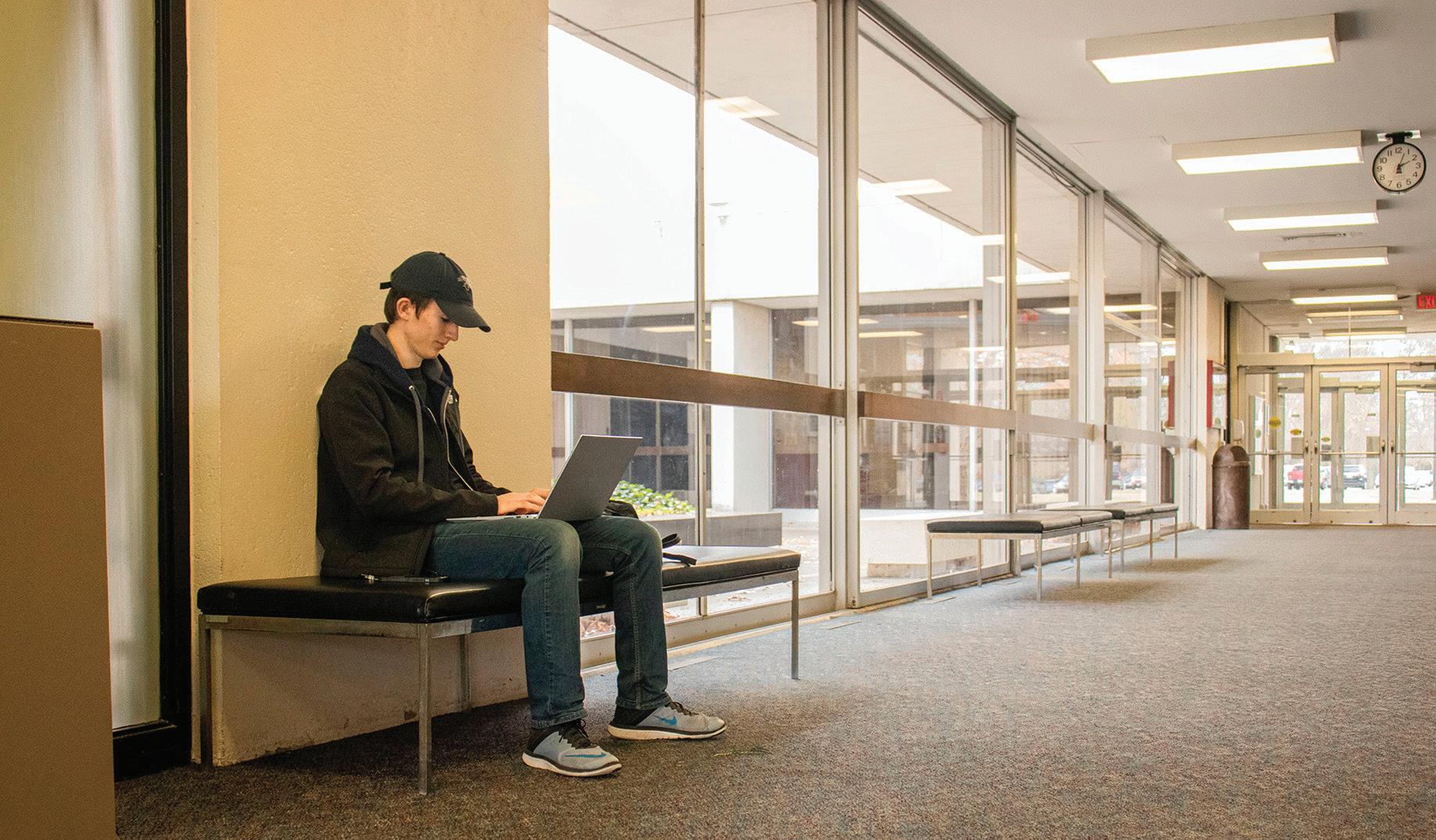

high school overall performed lower on standardized testing and college prep compared to other schools. I was allowed into SIU through the provisional program. This program provided me with mentorship, and they monitored my first-year progress to continue at the university.”
Helping underprivileged youth is one of Overton passions in life.
Keshawn altman Keshawn altman@siu eduGrowing up, Isaiah Overton never imagined himself attending college, much less serving as the campus’s Undergraduate Student Government (USG) president.

“I became interested in educational policy when I became president of the undergraduate student government. The opportunity to have a glance at the SIU school system and higher education in the state of Illinois was an experience that I could not pass up.,” Overton said.
His distinct upbringing is what makes him a successful leader.
“I grew up in Rock Island, Illinois with my three brothers and one sister. I was raised by a single parent, and she spent a lot of time between school and work. I spent most of my time at my grandparents’ house and participating in different afterschool programs,” Overton said. “Every other weekend I would travel to visit my father. However, I believed I was raised
by my community, and I value having learned from different perspectives. Those perspectives have helped me become wellrounded and objective as I approach different issues.”
During his childhood Overton experienced hardships that inspired his lifelong goal of wanting to help and serve others.
“The love and support I’ve received from people while experiencing pain and heartache from seeing my mother experience a low-income life and seeing my father be well off but distant from my life. In addition, seeing my mother in a lot of pain as a child urged me to find ways to make people happy resulting in my happiness. My goal in life is to ensure that my friends and family are happy and taken care of.”
The unusual path Overton took to get to Southern Illinois University (SIU) sets him apart from most students.
“I had a low GPA in high school and low-test scores. My
make by selling their fins, according to Kessel.
“In high school, I connected with [4H], in which leadership skills and planning community impact projects were learned. One of my proudest accomplishments was winning a 7,500 dollars national entrepreneurship grant to build my own leadership program for elementary students in our community. I targeted Rock Island Academy because it was understaffed and as a result its students were underresourced,” Overton said.
Overton stumbled upon USG and eventually ended up becoming its president.
“I never aspired to be president. I joined USG by accident my sophomore year of college. I was told to attend a meeting on behalf of my organization and was handed a senator petition form instead of a sign in sheet. I continued receiving invitations to attend future meetings and joined the funding board, in which I got to see the support that USG had to offer students. After that academic year was over, I had the opportunity to serve as vice president of finance. While there I worked one on one with organizations to help fund their events and initiatives,” Overton said.
Overton is proud of his role as USG president and loves the opportunity to be able to serve the student body.
“Assisting gave me the
from 3
Though some people may be happy with the extinction of sharks due to their perceived danger to people, Kessel said shark attacks on humans are extremely rare, and sharks benefit the ecosystem.
“Very basically they are upper level predators, some aren’t true apex predators, other species are more upper level predators, but when you have animals that are either very close to the top of the food web or close to the bottom of the food web they can have a slightly disproportionate effect on it. So their removal can be very disruptive in terms of ecosystem balance.”
Aside from causing prey species to experience disruptive population booms when they are gone, sharks also provide about 50,000 dollars each per year to the Bahamian economy in tourism money, much greater than the 300 dollars a fisherman is estimated to
One of Kessel’s most successful contributions to shark conservation was a study he started while getting his PhD at Cardiff University while working at Jupiter, Florida in 2007, a couple of years after a video surfaced showing a previously unreported behavior of lemon sharks in the Bahamas. Adult lemon sharks seemed to be aggregating in specific areas near the coastline, a behavior that had previously only been observed in nurseries. Just after the study had begun, in 2008, lemon sharks became an endangered species, due to the fact that sandbar sharks, the sharks with the next largest fin to body ratio in Atlantic coast shark fishery, were no longer legal to catch. Lemon sharks have two dorsal fins, the most valuable fin, and quickly attracted all of the fishing pressure in the area.
“We also knew that the lemon sharks were aggregating in this area where
the fishery was occurring in foreign waters,” said Dr. Kessel. “And like any aggregation, for example, if you targeted the spawning aggregations, you can very quickly decimate populations, not just the local population but the population of a much larger area.”
Researchers quickly set to work examining the shark gatherings, using a fishing technique they learned from an ex-commercial shark fisherman to capture lemon sharks and give them acoustic tag implants that would make a set of noises to trigger acoustic receivers placed along the east coast by various collaborating search groups, including Kessel’s.
Eventually, it was discovered that lemon sharks were migrating to the warmer southern waters of Jupiter, Florida (where the gulf stream from the gulf of Mexico first begins to warm the eastern seaboard) to weather the colder winter months, and then returning to reclaim their hunting grounds elsewhere
prospective to see what students are doing and what they hope to accomplish. I also consult with student leaders, faculty, and staff: to fully understand the framework of SIUC what students needed and the potential to influence those who choose to attend SIU.,” Overton said Sarah Ali-Brown, chief of staff at USG, is grateful to work alongside Overton as he leads her to success and gets her comfortable in doing a demanding job.
“Working alongside Isaiah has taught me so much. He continuously pushes me to do things outside of my comfort zone. I originally applied to be vice president of student programming, however he made me chief of staff. He felt as though this role would ultimately be best for me and would challenge me more. He was right, this job is no joke, but it has already taught me so much in the brief time that I have been there,” said Ali-Brown.
According to Overton, he observes students on campus struggling with their mental health and academics and believes that by assisting in improving their university experience, he is doing his lot to help.
“I put a spotlight on mental health and have shown the administration that no matter how a student looks or performs they could be dealing with emotional, social, and mental trauma. I’ve also worked to enhance the early alert warnings system on campus. This will allow faculty and staff to pinpoint students who may be at risk and need additional resources,” Overton said.
According to Grace Gunn, executive vice president of USG, “Isaiah has overcome some of
along the eastern seaboard. Their congregations were largely dependent on water temperature, coming when waters between December and April when water temperatures were less than 24 degrees centigrade, and leaving in April when the temperature went over 21 degrees centigrade.
Realizing the devastation local fishermen could cause to such dense groupings of sharks, the study, done in collaboration with the Nova Southeastern University in Florida, quickly sent its results to the Florida Fish and Wildlife Service, which oversees shark management and global fisheries in the Florida region.
“We specifically recommended the addition of the lemon shark to the prohibited species list of Florida state waters and very fortunately, lemon sharks were added to the prohibited species list for Florida state waters,” Kessel said. “It is currently illegal to target and kill lemon sharks in Florida
the biggest obstacles and has still managed to serve as one of the best presidents SIU has had. Also,he is the first and only president to be elected to serve a second term.”
Overton said he experienced many challenges while serving as USG president, but he is glad the position has brought out strength he never knew he had.
“The biggest obstacle I have faced was being diagnosed with bipolar disorder. So, when I started to have manic and depressive episodes, I didn’t know how to control or manage my feelings. During fall of 2020, I was hospitalized due to an intense manic episode. Upon release, I learned that bipolar disorder runs in my paternal bloodline. Extreme anger and frustration overcame me leading me further into a manic and depressive state. My mood finally began to level after a steady treatment from SIU psychiatry and CAPS. Every day is still a struggle though I have found much joy and hope in my positions, friends, and family at SIU,” Overton said.
Toussaint Mitchell, former president of USG, worked with Overton before graduating and was honored to have him serve as president.
“SIU is fortunate to have a president like Isaiah; he cares about the university and is among the smartest people I have ever met. I was concerned about who would take over as president when I graduated, but when Isaiah stood up, I knew he would excel in the position and accomplish remarkable things,” Mitchell said.
state. That was a really good success. This was not the typical trajectory for my research studies. It’s not normally this cut and dry, but this was a very nice condensed study that had a real world outcome from applied science.”
As effective as his study was, lemon sharks are just one of many vulnerable species. Kessel’s presentation also served as inspiration for students that share his passion for understanding and preserving the natural world.
“I love sharks, I love the ocean, I’m going for marine biology. I aspire to be a marine biologist, hopefully working at the Shedd Aquarium someday,” said Krystina Shadd, a student attendee of the event. “It’s gonna have to be a group effort where everybody’s gonna have to say, ‘hey, we’re all having this problem and we would like a change.’”
Daniel Bethers can be reached at dbethers@dailyegyptian.com or on instagram at commonitem6damage.



Family



Ill. Mo Collar | @m0.alexander
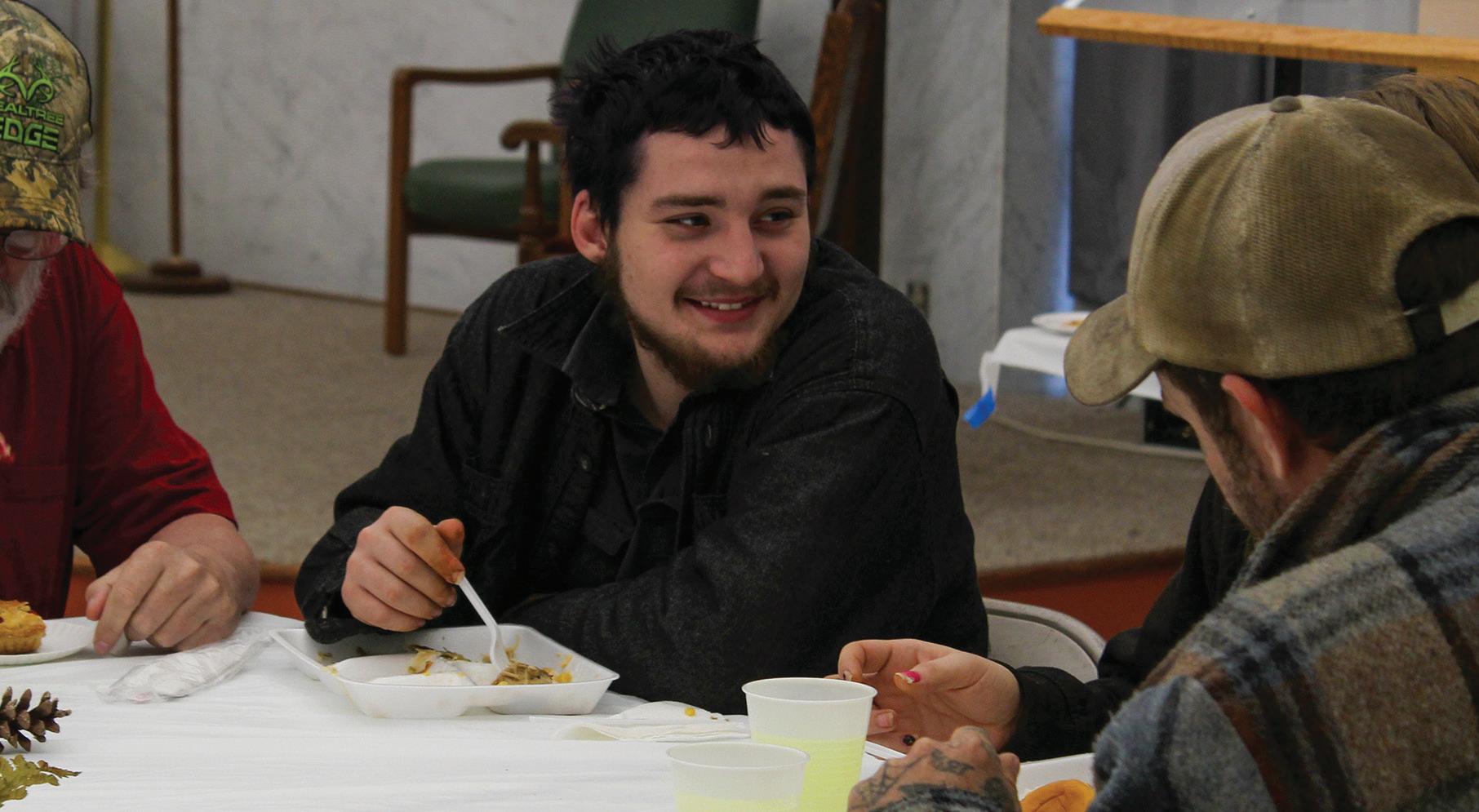






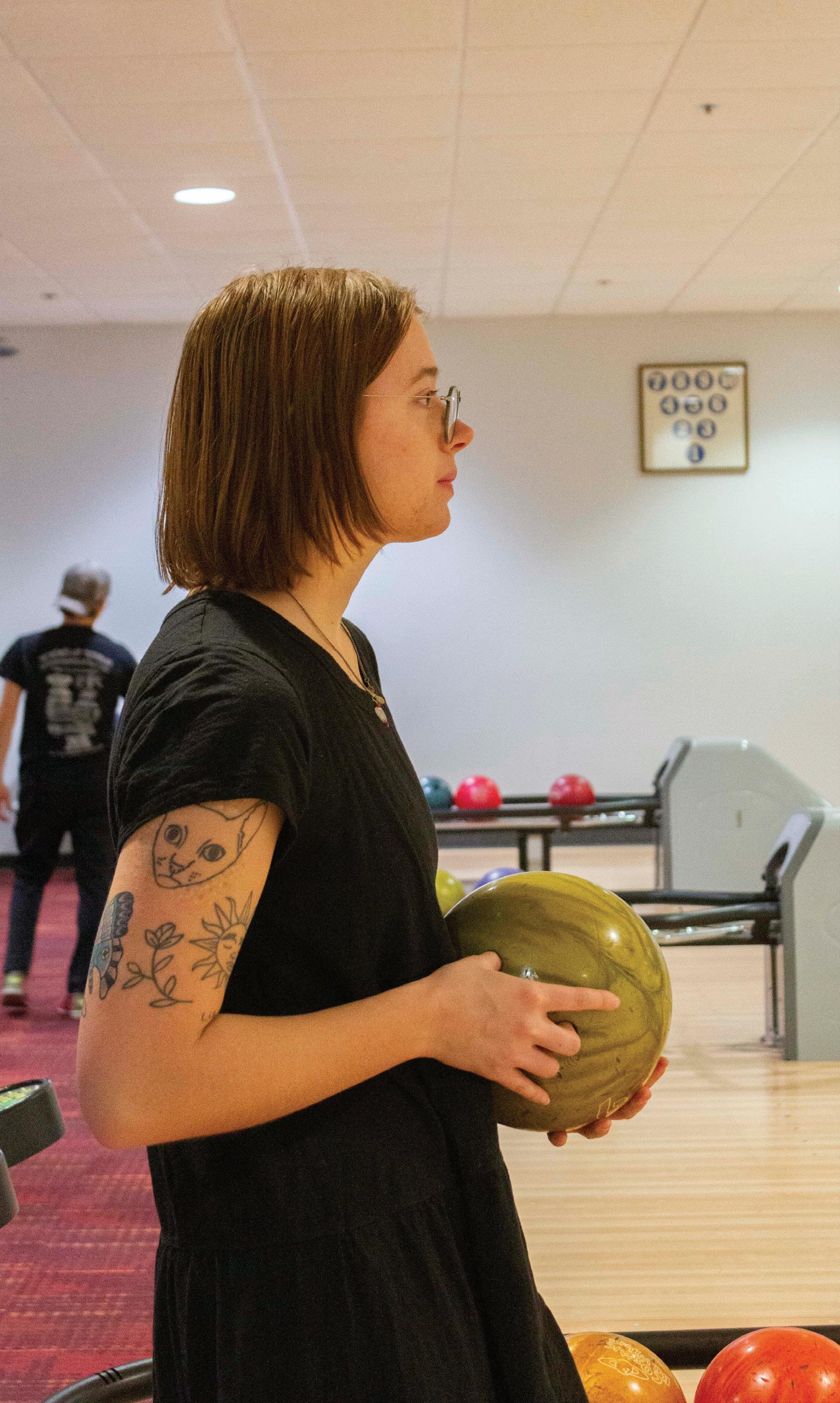


Bowling in the student center is always a great time, however on Wednesday nights it really comes to life for dollar bowling night. Every Wednesday from 6-9 p.m., the student center bowling alley has $1 games, shoe rentals and billiards.
This gives students a perfectly good excuse to step away from their books and long hours of studying to take a load off. It’s cheap, easy, and within walking distance for many students; it also gives many students the perfect opportunity to set up a routine with their friends to catch up and hang out.
Emmanual Blackwell said, “It’s always pretty steady on who comes in, sometimes there are new faces but often you have a pretty good guess on who will show every Wednesday.”
For many students, it becomes easy to forget to take time for themself and spend time with their friends when they have such a busy schedule. Sometimes the easiest way to solve that is by adding in an allotted time to do so, and that’s what makes it so special for so many friend groups.
“It’s always a good way to spend a few hours and it’s really affordable, especially to college students who might not have much to spend,” Fiona Douglas said.
Cost is always important to consider when going out with a group of friends. Bowling gives the perfect opportunity to have a good time while not breaking the bank for many students who are trying to save every penny.
Bowling also tends to be the perfect venue to host birthday parties or any special celebration you may want to have but can’t because of limited space or money. Bowling is a great group activity that leaves so much room for bonding.


Luke Douglas, who was celebrating his birthday at the lanes, said, “It’s a quick and easy option for a Wednesday night that otherwise wouldn’t have much else to do. It’s hard to not have fun while bowling with a bunch of friends.”
If your Wednesdays are fully booked don’t worry because the bowling center hosts a ton of other events such as lunch at the lanes, cosmic bowling and billiards night just to name a few. Not only are they fun, but they are relatively cheap compared to many other things you could be doing and it’s open all year.
So next time you have a spare moment be o-pin to new things and give bowling a spin.
The words “I’ll host!” slipped off my tongue a little too fast a few weeks ago when discussing the topic of my close friend, but would rather call her sister’s upcoming birthday festivities.


At the time, the thought of a dinner party in my home was basically a dream of mine. Although I am constantly shifting furniture and rearranging pictures on the walls, company is not really something we do often. Don’t get me wrong, I am constantly surrounded by friends and filling my home with laughter, but never in a formal setting.
The feeling of genuine exhaustion of post party haziness still lives on in my body four days after the dinner party that I hosted this past saturday night. With a head count of 13 after including myself, I knew that I was going to be very busy for the next few days.
After a thorough clean of the house, and a lot of mumbling to myself about the things that I did wrong this past weekend, I have compiled a list of rules to abide by when having a formal dinner party.
Rule one: Make sure that the food is warm, or someone will say something and you will get your feelings hurt.
Although this rule seems very obvious, who wants to eat cold food? The utter embarrassment of sitting at the head of your dining table and watching as everyone bites into the asparagus that you served and seeing their faces of a bit of discomfort as it had cooled to room temperature. I pursed my lips as everyone around me assured me that the food was fine, but I still see their faces haunting me in my head. I have decided to invest in a heat lamp from Rural King for my next occasion.
Rule two: If you use real china, put it in the dishwasher or you will regret it.
Now I know, this is frowned upon and wrong, but I would just like to say that if it isn’t sentimental, throw it on the rack. Leading up to the party, I was scrubbing my Noritake china by hand, and I was so very over it. After everyone had eaten and gotten up from the table for parlor games, I remained seated, being daunted by the mountain of dirty dishes that sat before me. As people left and a small group of friends hung around, I rolled up the sleeves on my floor length gown and began to scrub. After about five minutes and only having one plate truly clean, I swung the door open on my dishwasher and acted as if I was oblivious to the sounds
of my ancestors in my head telling Aaron Robert to stop what he is doing.
Rule three: Be prepared for people to touch your things.
This one was a bit hard for me as I am one of those people who will put an item at a very specific angle to give the full fantasy that I am always striving for. To me, my house is art, and I forget sometimes people have to be here, and that they will inevitably disrupt things. I didn’t notice it at the party at all, as I was too anxious for things to go right I could barely converse, but as I walk past things in my home, I will notice that a bust is looking the wrong way, or that my little lambs have been played with and that everything looks slightly different.
Rule four: Be prepared to drop a decent penny on the silliest things. Did anyone know that one table cloth costs 15 dollars? A plain white table cloth costs that much, and I needed two of them. Not to mention the price of literally anything nowadays. If you are a perfectionist like me, expect to drop a fat wad of cash on things that match. I somehow convinced myself that I needed to buy all matching cutlery and all matching water glasses.
Rule five: Talk to everyone.
My biggest mistake while running around like a chicken with its head chopped off was not giving everyone a proper conversation. I feel as a host, I should have sat down at some point with everyone and talked one on one with every guest that entered my home, but I didn’t. I was too worried about everything being as perfect as possible.
Rule six: If you can afford it, hire help.
Holy crap do I wish I was some big millionaire with gobs of money, throwing it at people to do things that I don’t want to. The most annoying thing to me was having to keep getting up while being surrounded by friends and family to get the next course, which was of course, cold. Of course, everyone thinks that life would be easier with some sort of butler and footmen, and I had to remind myself that this isn’t Downton Abbey.
Rule seven: Do not over pepper the soup.
Oh it was just hilarious to make a nice vegetable broth soup, just to serve it scalding hot and watch everyone’s faces turn a rather red color after taking a spoonful of soup. After serving cold asparagus, I had to laugh at the temperature and the amount of pepper
I put in the soup being too hot. As I dug into my soup, enjoying the fruits of my labor, I noticed that everyone else seemed to be pushing around their cabbage and celery in their bowls. I smiled as I dabbed my lips with my napkin, removing myself from the table to bring out the next course.
Rule eight: Have
I hope that this rule just happens without force, but try to have fun. Dinner parties are oh so exhausting, but extremely rewarding. If not for seeing the labor that you put into your home to make it more than suitable for your guests, then to taste the love and hard work you put into the food.
I learned a lot during this dinner party, and I took notes to make sure that next time is more smooth sailing. I definitely encourage anyone to take on the challenge, as it is something that is sort of being lost in society, and is a bit of a reflection of a bygone world, without really needing to be. Get your closest friends and family, and bring back a bit of pomp and circumstance into your life.
In 2018 “Black Panther” took over the world. The film succeeded far beyond any expectations and became one of the most successful Marvel films, financially and critically, as well as eventually becoming one of the highest grossing films of all time.
It was a major moment in film history, showing the level of success that a film could achieve that had a majority Black cast and crew. The film won three Oscars and was nominated for four others. Two of those Oscars, for costume design and production design, were both the first time an Black nominee had won either award.
“Black Panther” has since become a cultural touchstone, beloved by many and seen as an important text in modern American film history. A sequel was inevitable and was in development shortly after the initial film’s success. Although none could have ever predicted the tragedy that would befall its production, just two short years after the original’s runaway success.
The film’s leading man, Chadwick Boseman, who played the titular role, tragically passed away after his battle with cancer on August 28, 2020. This was a major shock to many, as his illness was a well-kept secret from the public, all the way up to his passing.
This placed the team behind “Black Panther: Wakanda Forever” in a massively unfortunate and difficult position, in that they knew they wanted to continue the story of the world of Wakanda but wanted to pay respects to the actor who the original film owes a lot of its success to.
Four years after the release of “Black Panther” and just two years after Chadwick Boseman’s passing, “Black Panther: Wakanda Forever” was released in theaters, on November 11, 2022. The film is a satisfying and successful sequel, despite the nearly insurmountable challenges that the team faced, including the COVID-19 pandemic.
“Wakanda Forever” immediately sets itself apart from the very opening, immediately delving into the death of T’Challa. The film deals with this reallife tragedy in the best way that anyone could have and is highly respectful both to the legacy of the actor Chadwick Boseman, as well as the character he helped create.
Following this emotional, but necessary prelude, the film continues to be an outlier from the rest of the Marvel Cinematic Universe in its moody tone and a dark color palette that is nearly unheard of for the franchise,
which is typically known for its overly bright, washed-out digital sheen.
The film is just as, if not more, beautiful than its predecessor, highlighting amazing worldbuilding for both Wakanda and the new location of the underwater Talokan city. Utilizing excellent set design, cinematography, and an atmosphere that reflects the tragedy and confusion that the audience feels, as well as the characters in the film itself.
The film’s director, Ryan Coogler, who previously directed
the first film as well as the equally crowd-pleasing “Creed”, continues to be one of the strongest directors working within the superhero film genre. His innate excellence continues to shine through even the most overwhelming of big budget blockbusters, which is especially unusual for films within the MCU, which are known for feeling anonymous, even when helmed by equally talented filmmakers.
“Wakanda Forever” is far from anonymous, highlighting immediately arresting locations and characters, always utilizing

the power of various filmmaking techniques to get the audience on board, always feeling effortless.
The characters and performances all shine in this very personal film, all of which are dealing with overwhelming grief and turmoil throughout the film’s nearly three-hour runtime. Letitia Wright, Angela Bassett, and MCU newcomer Tenoch Huerta all stand out, giving layered performances, all of which must communicate emotional and complex issues within the world of the film, and the real world as well.
The grief and emptiness that
Boseman’s passing has left is present in nearly every choice throughout the film, especially those who worked with him in the first film. Perhaps the most powerful choice Coogler makes is to begin and end the film with tributes to Boseman and allowing the actors to pay their respects, never letting the audience forget who the film is truly for.
The single most exciting aspect of “Wakanda Forever” though, is its villain. Namor, a fan favorite in the comic book world, makes his first live action appearance in the film. He leads the Talokan tribe, heavily inspired by YucatánMayan history and designs. His characterization continues in the same direction as the previous film’s villain, Killmonger.
Namor is a highly sympathetic villain, whose motivations are fleshed out, allowing the audience to be just as invested in him as they are Shuri, the film’s primary protagonist. Namor’s main goal is to protect his people and prevent them from being exploited, not unlike the Wakandan nation or Killmonger before him. This also continues in the series focus on the effects of colonization, exploitation of minority groups, as well as world politics.
Namor in the comics was always most known for his imposing and fierce presence, always doing whatever it takes to accomplish his goals. This is brought across perfectly in the film, making him feel equally smart as he is brutal. The Talokan tribe themselves are also a joy to watch, highlighting creative water-based combat sequences and hand to hand combat.
“Black Panther: Wakanda Forever ‘’ goes as far as to surpass the first film in its epic scale and atmospheric tone which also makes it one of the best MCU films, especially regarding its technical creativity. Although there are a few too many plotlines and the bloated runtime could feel exhausting in certain sequences, it still is massive blockbuster filmmaking at its best.
Ryan Coogler continues to be one of the most exciting directors working at this scale, delivering films that are as equally personal as they are crowd-pleasing. Although the film’s main purpose was to mourn the loss of Chadwick Boseman, it still succeeds as a fun, yet melancholy end to the current “Phase 4” of the Marvel Cinematic Universe.
Rating: 8/10
Staff reporter Zaden Dennis can be reached at zdennis@ dailyegyptian.com and you can find his other reviews at letterboxd.com/ Zadenator.
